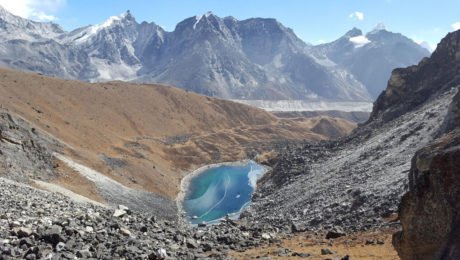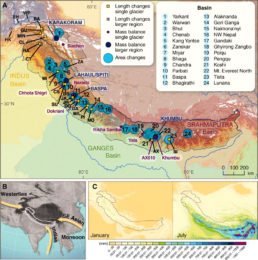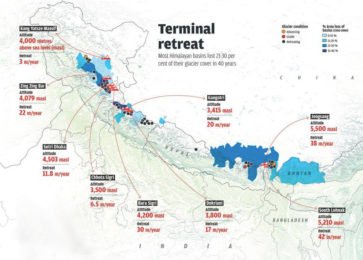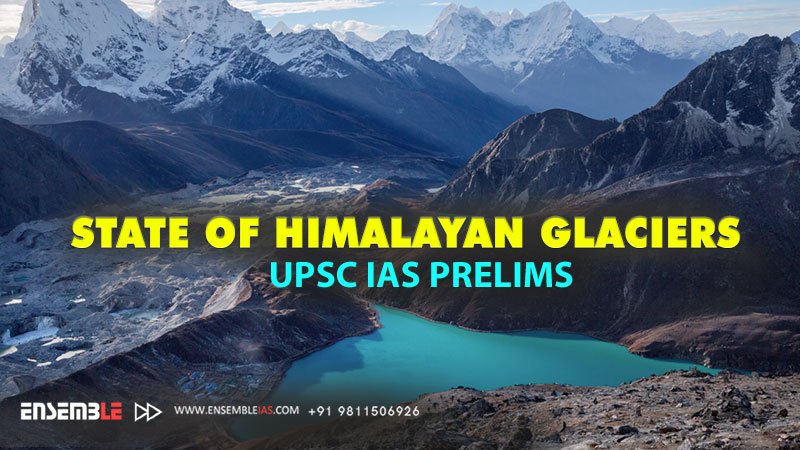State of Himalayan Glaciers
Shrinking of the glaciers has been a phenomenon throughout the world with major glaciers in the world receding. In this article, read about the withering state of Himalayan Glaciers and the steps to contain it.
Worldwide, the glaciers have reduced considerably in mass and surface area since the little ice age period.
Shrinking of the glaciers has been a phenomenon throughout the world with major glaciers in the world-Melaspina in Alaska, Hubbard in Antarctica and even in Norway, Alaska and Patagonia have all been receding. Every continent offers unmistakable evidence of the recession of glaciers. This recession comes with its own attendant problems.
To buy our online courses: Click Here
Like World, Indian glaciers too have been receding. Himalayan glaciers have been retreating and losing their mass faster than anywhere else in the world. Study of the last eight glaciers of the upper Rishiganga catchment Uttari Nanda Devi, Changbang, Ramni Bank, Bethartoli, Trishul, Dakshni Nanda Devi, Dakshni Rishi Bank and Raunthi Bank—had lost over 10% of their mass in less than three decades.
Read More: Save the Himalayan river systems
South-facing glaciers receded faster than north-facing ones, possibly because of longer exposure to insolation (solar radiation). It’s a different matter as glaciers also respond to climate and also dependent on their size and geometry.
Glacier recession in Himalaya

Glacier recession is best studied by the fluctuation of its equilibrium line. The equilibrium line which represents a balance between glacial accumulation and wastage, (the zone on a glacier where its mass lost is balanced by its mass gained over a year) swings in its altitude suggesting that glaciers in the Himalayas have responded to deprived precipitation conditions since 1980. Although temperatures have been increasing since the 1980s, glaciers are more sensitive to changes in precipitation.
The equilibrium line altitude fluctuated between 5,200m above sea level and 5,700m.
In the Himalayas, glaciers create a very different problem that includes
1. Shrinking glaciers form lakes at the mouth
2. Glacial Melting
3. Avalanche triggering caused by glacial snapping and landslide
4. Glacial damming
5. Glacial surge
6. GLOF
7. Presence of Black shoots and aerosols increasing albedo to speed up melting.
There 1,000 big and small lakes in the high mountains of Uttarakhand. Many of them are increasing in size. A lot of them do pose a threat of some kind.
1. An advancing glacier may overrun buildings or a small settlement. Villages near Chamonix in Switzerland were damaged during the ‘Little Ice Age'(1550-1860), which was a period of increased glacier activity and expansion.
2. Glacial surges, or sudden forward slip motion of glacial ice in valleys, can occur at up to 20 m a day. Although these surges tend to be much slower than avalanches, they are larger in scale and can overrun piedmont villages or farmland, thus causing widespread economic damage. An advancing or surging glaciers can block streams and impound lakes. Lakes may also form behind moraines (or even on the ice surface itself). Once dammed by debris, these Glacial dams can fail through any of several mechanisms such as (a) accelerated, erosion of a sub glacial (beneath) or englacial (within) tunnel; (b) hydrostatic flotation, (in which the pressure of dammed-up water floats the ice off its base and seepage that begins underneath it. This weakens the ice dam and can cause rapid floods.
3. Volcanic or geothermal activity in the midst of ice fields can cause floods through rapid melting denoted by the Icelandic word jokulhlaup (glacier bursts). These discharges are often exceptionally high.
4. Ice avalanches may occur from the snout of the glacier. If the snout is located at moderate altitudes, and ablation (i.e. melting and evaporation of the ice) causes it to be unstable, then the avalanches can be substantial. If the ice does not separate itself completely from its parent glacier, the phenomenon is known as a glacier thrust.
5. GLOF- Most of the glaciers that are receding also have debris cover. In India as in other places, it has led to the formation of a large number of glacial lakes all across the Himalayas. When glaciers normally melt, the water in glacial lakes accumulates behind loose, natural “glacial/moraine dams” made of ice, sand, pebbles and ice residue. This means as the glaciers retreat due to rising temperatures, the snow melts but the debris remains. This debris impounds the water and aids in the formation of a lake. Unlike earthen dams, the moraine dam which holds a large volume of water behind has a weak structure and abruptly fails. In the Himalayas, the frequency of the formation of these lakes has increased over the years, A failure of the debris dam has the potential of releasing millions of cubic meters of water in a short period, causing flash floods downstream. This event called as Glacial Lake Outburst Flood refers to the flooding that occurs when the water dammed by a glacier or a moraine is released suddenly.
Interestingly, there are not many GLOF (Glacial Lake Outburst Flood) that take place in Uttarakhand as they occur in Sikkim. This is because Uttarakhand has very steep slopes, and the water manages to find a way out.
Can glacial hazards such as GLOF be forecasted?
It is not possible to completely prevent GLOF and other glacial hazards. But their potential to cause destruction can certainly be minimized. There are examples. The Lhonak lake in Sikkim is one of the largest glacial lakes in the country. Recently, scientists have found a way to let the waters of this lake slowly drain at the nearby river at a regulated rate, so that there is no flooding, and the pressure on the lake does not become unbearable. Such solutions can be applied in Uttarakhand, and some work is being done in this regard.
• Monitoring
The first step in tackling the threat from these glacial lakes is to start monitoring the glaciers more actively and regularly. Of course, there is no need to monitor every glacier. Glaciers in one basin do not have remarkably different properties from another basin. Thus, if one or two benchmark glaciers in every basin are identified, particularly those that are more easily accessible, and their detailed studies done, then the results can be extrapolated to the rest of the glaciers in the basin or the state. It is important to get people and measuring instruments on the ground to monitor the situation. That is why accessibility becomes an important factor. Monitoring glaciers mean the measurement of the bathymetric changes, the mechanisms of expansion of the glaciers, changes in water levels, discharge balance, mass balance, and other attributes. It requires a lot of manpower and money.
• Forecasting can be based on several parameters.
Surveillance through Satellite forecasting humidity sensors, wind sensors and snow depth sensors, can be done by setting sensitivity zones. But relying only on satellites and remote sensing is not going to be enough.
1. Synthetic aperture radar imagery can be used to automatically detect changes in water bodies including new lake formation.
2. A dataset that tracks the progressive changes is crucial for any decision making.
3. There are other indices as well such as changes in water level of the lakes, monitoring Discharge of rivers, controlled discharge and breaching, pumping and siphoning out water and making a tunnel through the morainic barrier or under an ice dam.


• Structural geotechnical measures that includes Construction of channels for gradual and regular discharge.
It is possible to construct channels for gradual and regulated discharge of water from these lakes, which will reduce the pressure on them, and minimize the chances of a breach. At the same time, it also reduces the volume of water that goes into the flash flood. Also, alarm systems can be set up at the lakes, that will warn the community downstream whenever an overflow is likely to happen.
• Setting of comprehensive alarm systems. Besides classical alarming infrastructure consisting of acoustic alarms by sirens, modern communication technology using cell and smart phones can complement or even replace traditional alarming infrastructure. A preparatory response drill will also have to be worked out, like what India has done for cyclones and tsunami. Moreover, glaciology needs to be taken and instead as a part of policy intervention.
• Behaviour of fishes needs to be studied in detail as their movement and concentration can give a natural indication of such an event.
Moreover, Avalanches can be also be managed through mitigation. This includes
1. Modification of the path of avalanche movement.
2. To have control structures, such as, snow bridges, snow rakes, snow net, snow fences, avalanche gallery, diversionary dam, and earthen mounds.
3. Accurate forecasting and timely relaying of information would enable people, in the vulnerable areas down under, to escape to safe places.
4. Planting those areas with trees. A forest with thick growth of trees inhibits the formation of avalanches for the following reasons.
(a) Tree trunk support snow cover and provide an anchor to prevent the movement of the avalanche
(b) Snow drifting is slowed down.
(c) Tree canopy retains snow and releases it gradually to form a stable cover on the ground
(d) Forest canopy stabilizes the snow.
5. Avoid travelling during daytime from 09.00 AM to 04.00 PM. Usually, avalanches get occur at this time.
6. Traveller and Trekkers should carry with them safety and sound alarm, as the time that one can remain trapped under an avalanche is about 10 to 15 minutes.
7. Snow Dogs, avalanche dogs like St Bernard are efficient in detecting people, trapped under the snow.

K. Siddhartha is a renowned Civil Services Preparation Mentor and Thought Leader. He has more than 20 years of experience and has mentored over 1550+ civil servants, film personalities, entrepreneurs, and policymakers. Mr. K Siddhartha is the author of 43 books & 116 research articles. He is frequently invited as a speaker on global platforms. (Views are personal)
Published in Jagran Josh on 18/03/2021. In this article “State of Himalayan Glaciers.”




